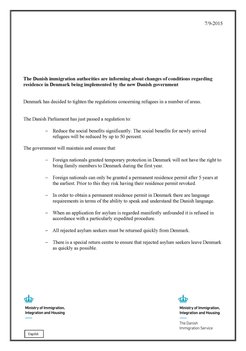The Danish song is a young, blond girl
Author: Anne-Erita G. Berta
In a guest Editorial in Anthropology Today, Chris Hann (2019) informs us that the rise in nationalist populism in Hungary today ‘is a product of neo-liberal EU institutions which have reduced the country to a new state of peripheral dependency’. He explains this with Hungary becoming member of the European Union and how the expectations of increased material wealth were never met. The reasons for growth of populist (xenophobic) nationalism in Hungary are easy to detect if you know just a little about the country’s political and economic history. But the rise in xenophobic nationalism in Denmark can hardly be explained in the same way.
Compared with Hungary, Denmark offers the individual citizen an incomparable level of social security with universal free education, healthcare, and unemployment insurance for all citizens, regardless of their level of contribution to the welfare state. Denmark is a small country, in this respect similar to Hungary, but with less than half the population. Like Hungary, historically it has been an important power in its region with colonies and control over large land areas. However, Danes strongly identify as a small nation with a small and homogeneous population. The country has one of the world’s most restrictive immigrant laws. In the wake of the large flow of refugees that arrived in Denmark (and the rest of Europe) in 2014-2016, the state has largely succeeded in its aggressive measures to discourage refugees from seeking asylum in Denmark through internationally dissuading migrants, especially those originating in the Middle East (see https://www.thelocal.dk/20150907/denmarks-anti-refugee-ads-published-in-foreign-papers).

Despite the low number of immigrants and asylum seekers arriving in Denmark, the Danish Populist Party is even when not in government continuously campaigning to reduce the number still further. Most Danish political parties support a restrictive immigrant policy, usually citing the cost to public welfare budgets. In 2015 Danish local governments stated that they would have to reallocate resources from institutions for the elderly to pay for a growth in the number of accepted asylum seekers. This and similar scare tactics have nurtured a growing interest in the population to protect what is Danish and keep others out.
In late December 2018, the song ‘The Danish song is a young blond girl’ (Den danske sang er en ung blond pige) sparked a debate across the nation when a non-ethnic Danish employee at the Copenhagen Business School (CBS) made a complaint to her leader that she was offended by the contents. The case was handled internally, and the leader apologised and removed the song from the morning meetings. It was only a year later that the news of this event reached the public and a case, which the CBS department leader himself expressed was an undramatic event, reached national news (see: https://www.dr.dk/ligetil/ligetil-paa-tegnsprog/underviser-paa-cbs-foelte-sig-kraenket-af-sang-fra-hoejskolesangbogen). The song, which was written in 1924 by a composer on the central island of Funen, at a time when the country was much more ethnically homogeneous than it is today, was dropped as the opening song at internal morning meetings and the department leader at the Business School apologised.

The case sparked discussion across the country as to whether the song should be removed from the music curriculum, where it is apparently very popular. Most contributors argued that the song was taught with an implicit understanding that it was written in a different era, and that therefore no one should be offended. Sentiments about censorship of Danish history were expressed by the Prime Minister, who said that he was shocked that manager and a senior academic at CBS had offered an apology and removed the song. The public similarly reacted with comments such as ‘I, as a Dane feel offended by this. Let Denmark be Denmark’, ‘we need to be careful not to get Swedish conditions (svenske tilstande) where everything old must be re-written’, together with direct verbal attacks on Muslims, the principal target for Danish xenophobia.
The fact that this case received so much attention in the media and the engagement on the part of members of the public suggests we are dealing with protectionist nationalism. Almost no one pointed to the simple fact that Denmark can no longer be symbolised exclusively by blond hair and blue eyes only (as in the lyrics of the song). Instead, the case provided an excellent opportunity for populists to attack fellow-citizens who were not of Danish heritage. Perhaps more interestingly, many who did not think of themselves as at all nationalist, as having negative attitudes to non-ethnic Danes, were drawn into the fray. Whereas the CBS staff member had tried to draw attention to a pattern of social exclusion, the upshot was that even those who self-identified as pluralists were mobilized in support of Danish cultural heritage. The public debates focused not on the fact that a colleague felt offended by a nationalist song that excluded her on the basis of her phenotype, but instead on the CBS leadership, which had apologised for something it should not have apologised for. Politicians, university professors, and numerous individuals joined the debate, all focusing on the absurdity of feeling offended by a Danish song.
What can this case teach us about Danish nationalism, and how can we explain its growth? The 2019 version of Danish nationalism is eerily similar to 1924 nationalism, when blonde hair and blue eyes were unchallenged as the dominant symbols of Danishness. The main concern seems still to be conservation of this state, oblivious of the fact that culture and Danishness are not a static condition, but a process of constant change.
I base my diagnosis of ‘protectionism’ in part on my own experience with nationalism, ethnicity, and xenophobia during fieldwork in Aarhus in 2015–2016. Interlocutors who were outspokenly negative towards immigration, and especially Muslim immigrants, and those who were not, were equally concerned with protecting what they believed was ‘Danish.’ What they had in common was a fear that Denmark was not big enough for more people coming from the outside.
Supporters of the Populist Party Dansk Folkeparti believe that immigrants are reluctant to embrace ‘Danish culture’ and therefore represent a threat to Danish society. But others, though less outspoken about immigrants, were just as concerned with protecting what they believed to be ‘Danish values’ (Danske værdier), ‘Danish culture’ (Dansk kultur), or simply ‘Danishness’ (Danskhed). All seemed to agree that skin colour and ethnic origin were of minor importance if the person was willing to adopt and fully integrate into Danish culture, norms, and society (Larsen 2011).
For example, Marie and Ole, a couple who supported left wing socialist politics, were concerned about the growing number of immigrants. Though basically positive towards multiculturalism and its new impulses, they shared the populists’ concern over the high cost to the welfare state. The Danish obsession with homogeneity disguised as equality (understood as sameness) is not a new phenomenon in Scandinavian societies (Bendixen, Bringslid, and Vike 2018; Jenkins 2011). What is new in the present nationalist wave is the more aggressive attitude shown towards some foreigners, especially Muslims.
John L. Campbell and John A. Hall (2017) argue that whereas left-leaning cosmopolitans in bigger countries like Great Britain and France tend to be strongly pro-multiculturalism, urban citizens in smaller countries like Denmark have a tendency to be more negative towards change. This protectionist tendency can be explained by an enduring state of religious, linguistic, and ethnic homogeneity, which according to Campbell and Hall (2017) is indispensable to the success of small nations. The welfare state and the facilitation of universal education from a very early age are hard-won achievements that make citizens proud of their nation and keen to sustain what they perceive to be its core values. It is not merely a constant state of vulnerability against larger, stronger nations and markets, as Campbell and Hall (2017) suggest. Danes are subjects of the idea that “The Good Life is a Life of Conformity” (Stenius 1997) and see their social security as the resulting from a consensual population. The obsession with sameness and homogeneity did not arrive with modern nationalist movements but derives from historically anchored conditions that I have analysed in my dissertation (Berta 2019). With the global rise of strident, populist variants of nationalism, these sentiments are nurtured in new ways. Small-nation vulnerability feeds into these sentiments.
References
Bendixen, Synnøve, Mary Bente Bringslid, and Halvard Vike, eds. 2018. Egalitarianism in Scandinavia: Historical and Contemporary Perspectives. Approaches to Social Inequality and Difference. Palgrave Macmillan.
Berta, Anne-Erita G. 2019. Entrepreneurs Against the Market: Morality, Hard Work, and Capitalism in Aarhusian Independent Businesses. PhD Thesis, Halle/Saale: Martin Luther University Halle-Wittenberg.
Campbell, John L., and John A. Hall. 2017. The Paradox of Vulnerability: States, Nationalism, and the Financial Crisis. Princeton and Oxford, New York: Princeton University Press.
Hann, Chris. 2019. ‘Anthropology and Populism’. Anthropology Today 35 (1): 1–2.
Jenkins, Richard. 2011. Being Danish: Paradoxes of Identity in Everyday Life. Copenhagen: Museum Tusculanum Press.
Larsen, Birgitte Romme. 2011. ‘Drawing Back the Curtains: The Role of Domestic Space in the Social Inclusion and Exclusion of Refugees in Rural Denmark’. Social Analysis 55 (2): 142–58.
Stenius, Henrik. 1997. ‘The Good Life Is a Life of Conformity: The Impact of the Lutheran Tradition on Nordic Political Culture’. In The Cultural Construction of Norden, edited by Øystein Sørensen and Bo Stråth, 161–73. Oslo, Stockholm, Copenhagen, Oxford, Boston: Scandinavian University Press.

